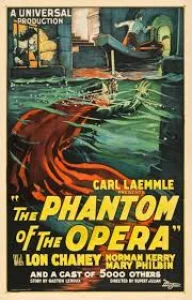Beneath the Opera: How 'The Phantom of the Opera' (1925) Unleashed a Classic Horror Icon and Defined a Golden Age!
In the silent, flickering magic of early cinema, few studios grasped the terrifying allure of the macabre quite like Universal Pictures. As the 1920s roared, Universal was already laying the groundwork for its legendary monster universe, building on the success of German Expressionism and a public hungry for gothic thrills. Into this fertile ground came The Phantom of the Opera (1925), a monumental achievement that didn't just adapt Gaston Leroux's classic novel; it reimagined it, casting an unforgettable shadow over the nascent horror genre and establishing a new benchmark for cinematic terror. At its heart was the unparalleled genius of Lon Chaney, the "Man of a Thousand Faces," whose chilling, self-designed portrayal of the Phantom became one of the most iconic and terrifying figures in film history. This film was a spectacle of grand scale, a masterclass in suspense, and a critical cornerstone that helped define the visual language and thematic power of the Universal Monsters, proving that true horror could reside not just in the supernatural, but in the depths of human obsession and despair.
The film plunges into the magnificent, labyrinthine depths of the Paris Opéra House, a world of glittering glamour built upon a shadowy underworld. Here dwells Erik (Lon Chaney), a deformed musical genius, a mysterious figure who lurks beneath the stage, secretly manipulating the opera's affairs and tormenting its inhabitants. His obsession lies with the beautiful young opera singer Christine Daaé (Mary Philbin), whom he secretly coaches and manipulates, believing her to be his protégé and destined for stardom. When Christine's childhood sweetheart, Raoul de Chagny (Norman Kerry), attempts to intervene and protect her, Erik's possessive love transforms into a terrifying rage. The stage is set for a chilling battle for Christine's soul and freedom, as the Phantom unleashes his terrifying wrath upon the opera house, demanding her love and creating a reign of terror that threatens to consume everyone in its path.
Rupert Julian's (and uncredited others') direction, despite its turbulent production, orchestrated a breathtaking spectacle, blending grand operatic melodrama with spine-tingling horror. The film's production design is simply extraordinary, meticulously recreating the opulent interiors and subterranean catacombs of the Opéra Garnier, transforming it into a character itself – a living, breathing entity that harbors both beauty and monstrous secrets. The use of elaborate sets, stunning cinematography, and a palpable sense of atmosphere pulls the audience deep into the Phantom's eerie world. The famous "unmasking scene," where Christine rips off the Phantom's mask to reveal his grotesque, skull-like face, remains one of the most shocking and iconic moments in cinematic history, a testament to Chaney's horrifying makeup and the film's relentless build-up of suspense. It’s a visual feast that, even in silence, speaks volumes of terror.
The Phantom of the Opera was a massive box office success, cementing Lon Chaney's legend and Universal's horror dominance. Its cultural impact is immeasurable, inspiring countless adaptations on screen and stage (most notably Andrew Lloyd Webber's musical). Lon Chaney's self-designed, terrifying makeup for the Phantom was legendary for its realism and his commitment to the role, famously keeping it a secret until the film's premiere. The film underwent significant re-shoots and re-edits before its final release, and famously contained some early Technicolor sequences for the masquerade ball scene, adding a splash of vibrant color to its predominantly monochromatic world. It remains a timeless cult classic, a silent masterpiece that continues to haunt and fascinate, proving that some horrors, and some love stories, are eternal.
Director: Rupert Julian (with uncredited contributions from Edward Sedgwick, Lon Chaney, and Ernst Laemmle).
Cast: Lon Chaney as Erik, The Phantom, Mary Philbin as Christine Daaé, and Norman Kerry as Raoul de Chagny.
Special Info/Trivia: Lon Chaney famously designed his own grotesque Phantom makeup, keeping it a secret from everyone until the film's premiere. The film initially had a troubled production with multiple directors and re-shoots. It featured early Technicolor sequences (specifically for the "Bal Masqué" scene) in some prints, a rare and innovative use of color for its time. The original film was adapted from Gaston Leroux's 1910 novel. It was a massive box office hit and became a foundational film for the Universal Monsters franchise.

